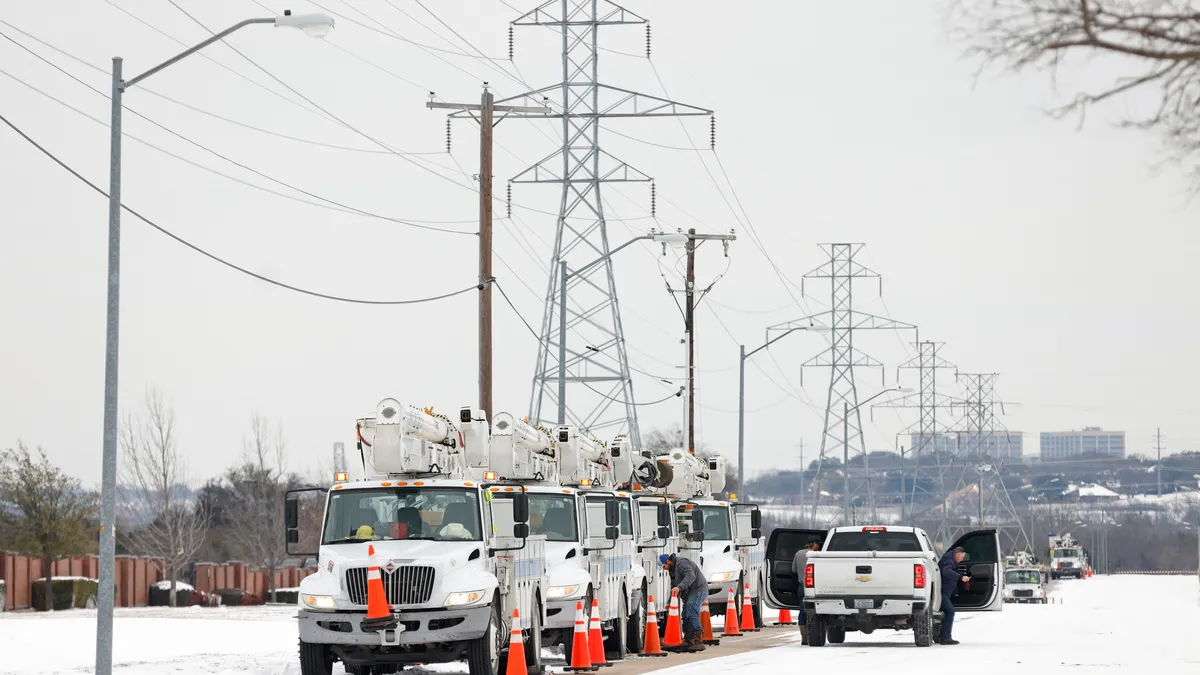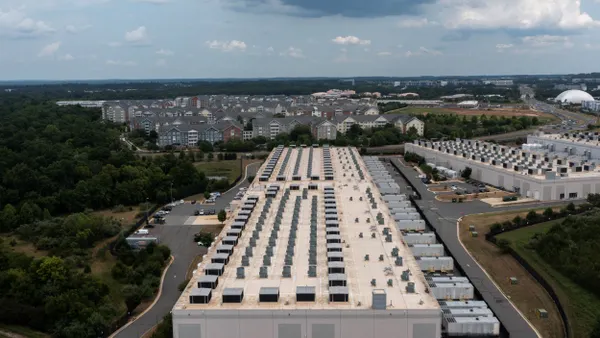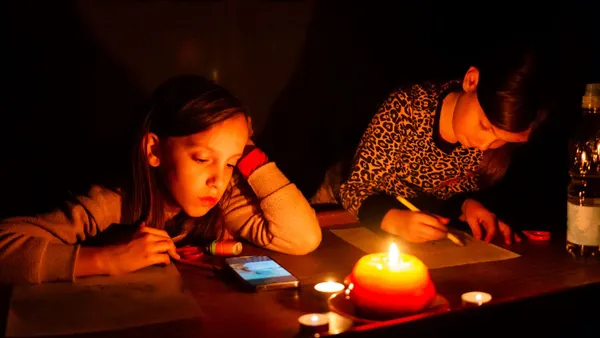The following is a contributed article by Dan Esposito, senior policy analyst at Energy Innovation, and Eric Gimon, senior fellow at Energy Innovation.
Editor's Note: This is the first of a three-part op-ed series in Utility Dive based on Energy Innovation's research examining 1) what drove the extended Texas outages, 2) the degree to which energy markets failed, and 3) how different entities can improve U.S. energy market and power infrastructure resiliency against extreme events while decarbonizing the grid to mitigate future climate risk.
When February's polar vortex brought historically rare freezing temperatures to Texas, the Electric Reliability Council of Texas (ERCOT) initiated rotating outages to prevent the power grid's collapse, leaving millions of Texans without electricity for days. The ensuing crisis (deemed the "Big Freeze") led to residential heating shortages, burst pipes, water treatment plant failures, and an estimated 700 deaths — all of which disproportionately affected low-income communities of color.
The incident was covered as an isolated event, but climate change threatens grid stability across the United States. Recognizing this, new research from Energy Innovation identifies the root causes of Big Freeze-driven power outages to offer lessons for policymakers in and beyond Texas. While climate change mitigation efforts are critical, they must be paired with smart resiliency measures to protect against increasingly common climate-related disasters — such as deploying demand-side measures like weatherizing homes, taking a more holistic approach to risk management, and planning for "managed failure" of the grid.
In the tragedy's wake, disingenuous commentary blocked productive public discourse, and several parties capitalized on power sector complexities to redirect blame or leverage national attention to further their agendas. For example, Texas Governor Greg Abbott, R, attacked wind and solar, falsely blaming them for the power outages. While the state's energy market has made it a renewable energy leader, natural gas still provides more than half of its electricity. Evidence shows natural gas was chiefly responsible for the power supply shortage and that a high renewable energy system could have performed better.
Climate-related disasters will become increasingly common, even as the world decarbonizes, making extended outages like those in Texas possible anywhere:
- In 2017, Hurricane Maria severely damaged Puerto Rico's power grid, with a quarter of the island's residents still in the dark five months later.
- In California, utilities shut off power for millions of residents in recent years to prevent live transmission lines from blowing into dry foliage and sparking wildfires, and wildfires themselves pose additional risk to energy infrastructure.
- In 2020, Tropical Storm Isaias downed trees, cutting power to 1.4 million New Jersey customers.
- Connecticut officials recently estimated that a Category 3 hurricane could leave its residents without power for months.
Sober diagnosis of the Big Freeze is essential to help lawmakers and regulators across the U.S. prepare for inevitable future system shocks and protect their states' residents from physical and financial harm.
The challenge of high-impact, common-mode events
ERCOT is tasked with ensuring just enough supply of electricity to meet demand at any given moment, as too large an imbalance can trigger a system-wide blackout. It has successfully performed this function at low cost during ordinary and extreme conditions — in fact, Texas residents paid below the U.S. average for power over the last decade, with ERCOT keeping the lights on through periodic heat waves.
However, the Big Freeze falls well beyond "ordinary" and typical "extreme" conditions into a third category: high-impact, common-mode events. In these events, a "common mode" causes failure across many seemingly independent system components, compounding the impact of any one piece failing.
Cold weather was the common mode in the Big Freeze, causing power plants, natural gas production wells, and other critical energy infrastructure to freeze and cease operations. The cold also drove electric demand to near-record levels, as electricity meets about 60% of heating demand in Texas, often through inefficient systems.
The need to balance supply and demand led ERCOT to employ planned outages, though these too were mishandled. Poor planning left some communities with uninterrupted power while others suffered in the dark for days. This compounded hardships faced by Black and Hispanic communities in particular, who have fared worse through the COVID-19 pandemic and whose neighborhoods disproportionately consist of older and less efficient homes. An ERCOT program compensating industrial facilities to reduce power consumption also backfired, as many participants ordered offline were critical to the state's natural gas infrastructure.
Failures throughout the natural gas infrastructure system starved the grid of power
A shortfall of available natural gas power generation was the Big Freeze's main culprit. Texas natural gas production fell by 45% due to frozen wells, frozen pipes, and a lack of electricity to manage other gas infrastructure components, leaving some generators without fuel to burn. Other power plants had access to gas but weren't designed to operate in such cold conditions.
These gas power generation shortfalls could have been avoided simply through sufficient winterization, but winterization has been (and currently remains) optional under Texas regulations. Given the perceived low risk of an event like the Big Freeze, market participants in ERCOT's highly competitive environment have opted to forego such measures.
Huge swaths of the sprawling natural gas system may need winterization retrofitting to address this problem going forward, as gas-fired power plants need access to the fuel to operate. With more than 120,000 gas producing wells, nearly half a million miles of pipeline, and nearly 70 GW of gas-fired power plants, retrofit costs could quickly balloon. The price tag may be more tolerable if only a small subset of the system or new gas infrastructure must be winterized, but such estimates ignore stranded asset costs of moving away from gas — and in any case, those funds would likely see a higher return if put toward demand-side measures.
On the other hand, wind farms can be winterized for as cheap as 5% of installed prices, cost-effectively preventing frozen turbines. With no fuel production and transportation network necessary for wind farms to operate, the costs stop here. As wind development must boom over the next decade to meet U.S. decarbonization goals, winterization during construction could limit subsequent retrofit costs.
Despite false rhetoric, a technical analysis from Vibrant Clean Energy suggests wind "actually provided support over the winter storm," with solar producing better than expected. Preliminary models also show that a Texas grid supplied predominantly by wind, solar, and energy storage would perform better than the existing gas-led system — particularly if the state built new transmission connections with neighboring regions to share resources as weather systems move across the continent.
Inefficient buildings and poor communication contributed to high electricity demand
ERCOT was also faced with 14% higher demand than its worst-case estimate of extreme winter conditions. The residential sector was responsible for most of this demand spike, as residential loads may have increased up to 250% during the Big Freeze due to four factors:
- Building codes in Texas were historically inadequate, especially prior to 2001, resulting in most of Texas' housing stock leaking warm air and straining for more.
- Incentives to weatherize homes have had only limited impact; for example, state and federal weatherization programs improved only 0.1% of Texas from 2010-2016.
- Residential electricity rates are generally flat, removing any financial incentive to use less energy during high-demand conditions.
- Regulators and market operators have no coordinated plan to communicate with homeowners to lower their energy use.
Texans therefore had no awareness of the looming crisis, no reason to keep thermostats low in cold weather, and homes that needed to continually cycle hot air to replace that which seeped outside. Meanwhile, demand-side measures to promote targeted energy conservation and home weatherization could have paid for themselves many times over during the Big Freeze.
Scrambling to prevent a blackout, ERCOT moved forward with its only remaining option — controlled outages that artificially reduce demand to match available supply.
Durable solutions must look beyond fossil fuels
A brute force approach to planning for high-impact, common-mode events would mandate the construction of 10 new winterized natural gas-fired power plants with fuel storage on site. While it may work in theory, the plan is anticompetitive, very expensive, and devoid of supplemental societal benefits like reduced emissions and energy bills from weatherizing buildings.
Instead, the plan would harm communities forced to sponsor the new plants through added pollution and further entrench natural gas infrastructure when the U.S. must rapidly transition away from fossil fuels — something we can and must do without building any new gas-fired power plants in order to meet America's target of reducing greenhouse gas emissions 50-52% by 2030. As you can't dig your way out of a hole, you can't make burning more fossil fuels central to addressing climate change-driven crises.
Understanding the policy decisions and market failures that exacerbated the Big Freeze is imperative for designing solutions, which we'll discuss in this series' second article. Policymakers can then implement sustainable, holistic solutions that rise to the complexity and interrelatedness of such events, like improving building codes, creating a resilience fund, and upgrading the distribution grid to allow for more surgical rotating outages — which we'll discuss in the third article.














